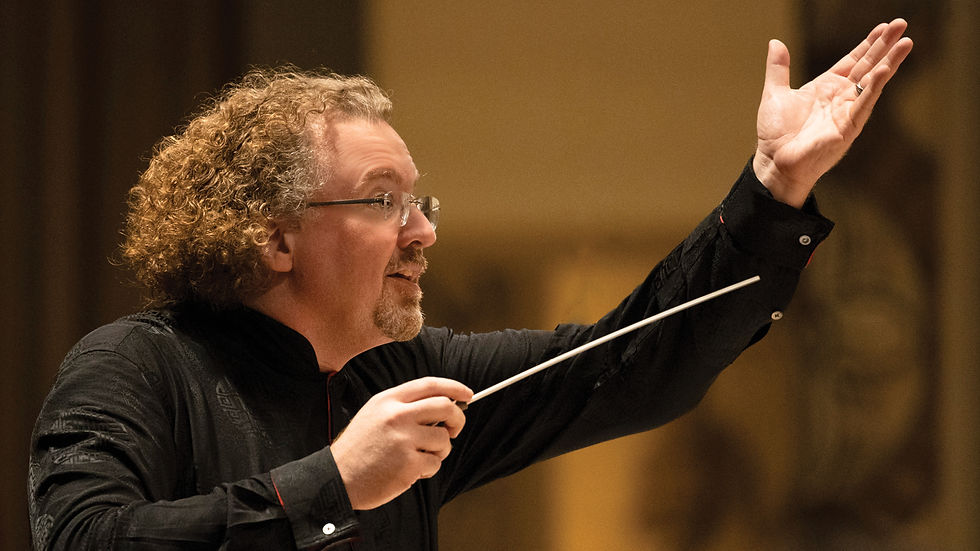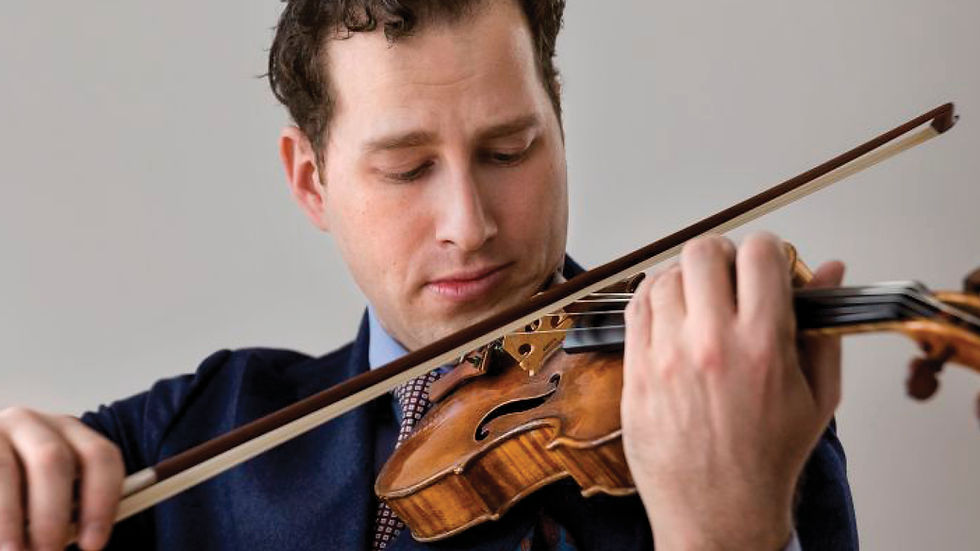Program Notes: Rachmaninoff's Third Piano Concerto (October 1-2, 2021)
- SLSO
- Sep 27, 2021
- 6 min read
Program
Stéphane Denève, conductor
Yefim Bronfman, piano
Caroline Shaw
Entr'acte (2014)
Charles Ives
The Unanswered Question (1906)
Christopher Rouse
Rapture (2000)
*Entr'acte, The Unanswered Question, and Rapture will be played without pause.
Sergei Rachmaninoff
Piano Concerto No. 3 (1909)
Allegro ma non tanto
Intermezzo—Adagio Finale: Alla breve
Yefim Bronfman, piano
Program Notes
By Tim Munro
Stéphane on this program
I was curious to see what happened if we played the first three pieces together, without a break. I love the idea that when you listen to something it influences the way you enter into the other musical worlds.
Caroline Shaw’s Entr’acte ends with solo cello, strumming the same chord that begins Charles Ives’ The Unanswered Question. I dreamed that there would be the right feeling for Ives’ amazing chord, which should sound as if it has always been there.
The Unanswered Question is visionary—no other piece really compares. I’m fascinated by the by the capacity of Ives’ music to dismantle time. The chord that ends the Ives resolves into the opening of Christopher Rouse’s Rapture, and Ives’ small orchestra expands into the full orchestra of Rouse’s work.
This trilogy takes us on a journey through three generations of American composers—three different musical voices, each answering one other.
If the first half asks the perennial question of existence, then the second half gives the answer: love—the ecstasy of love, the light of love. I associate Sergei Rachmaninoff with a pure expression of this love.
Rachmaninoff’s Third Piano Concerto was one of the first concertos I conducted. And I almost played it—my piano teacher wanted me to take part in the Queen Elizabeth competition, and I would have played this concerto.
Fima, as Yefim Bronfman is known to his friends, is incredible. What an artist, a virtuoso. It is always about music with him.

Entr'acte
Caroline Shaw
Born August 1, 1982, Greenville, North Caroline
Caroline Shaw is a thoroughly modern musician. The Brooklyn-based, Pulitzer Prize–winner keeps a hectic professional schedule as violinist, vocalist, composer, and producer.
Escaping the rush of this modern world, Shaw looks to the past for musical inspiration. The spark for Entr’acte came during a performance Franz Joseph Haydn’s String Quartet, Op. 77 No. 2. Shaw found a transition in the Minuet and Trio movement striking, a “spare and soulful shift.”
Entr’acte often leans to the edge of silence. The strings seem to center themselves around the breath. Breathe in: silence. Breathe out: music.
Repeat. Shaw’s music feels close to tears, yet retains an inner peace. Historically, an entr’acte is an interlude between acts of a play or opera.
Shaw’s work has no such function, but the music does have a transitory quality. Uncertain about what might come next, uncertain about how we might get there.
First performance: 2014, by A Far Cry, in Boston, Massachusetts First SLSO performance: this version, this weekend’s concerts. String quartet version, October 30, 2020. Instrumentation: Strings Approximate duration: 11 minutes

The Unanswered Question
Charles Ives
Born October 20, 1874, Danbury, Connecticut
Died May 19, 1954, New York, New York
The music of Charles Ives often offends decorum: marching, shouting, rabble-rousing. But Ives also reached for the mystical, the ecstatic. “For the spirit,” he wrote, “that underlies everything in this teeming, tragicomical, singing world. A vision higher and deeper than art itself.”
Ives spent his life asking big questions. Wealthy from his successful career as an insurance salesman, he lived simply and read widely. His spiritual beliefs were complex and ever-shifting, drawing from Christian faiths, as well as transcendentalism, a belief that god is in everything and every person.
The Unanswered Question pulls time apart. Three groups of musicians ignore one another: the strings, representing “The Silences of the Druids” who see and hear nothing; the trumpet, asking “The Perennial Question of Existence;” the woodwinds, who are the “Fighting Answerers.”
But what is this “Perennial Question of Existence?” Does it question existence, morality, or religious belief? Or does it ask us something more mundane?
Perhaps The Unanswered Question allows us something rare and precious: a moment of stillness, to find our own quiet space to consider. To question. And, perhaps, to answer.
First performance: May 11, 1946, at Columbia University in New York City, performed by students from the Juilliard school, Edgar Schenkman conducting, with Theodore Bloomfield leading off-stage strings First SLSO performance: January 2, 1959, Aaron Copland conducting Most recent SLSO performance: November 20, 2016, David Robertson conducting Instrumentation: 2 flutes, oboe, clarinet, trumpet, strings Approximate duration: 6 minutes

Rapture
Christopher Rouse
Born February 15, 1949, Baltimore, Maryland Died September 21, 2019, Baltimore, Maryland
Quiet hymns fill the hall. Slowly, woodwind birds lift and flap and glide. Brass and percussion kindle a fire, which flickers through the orchestra. Finally, jubilation overwhelms.
Christopher Rouse had a long history with the St. Louis Symphony Orchestra. The SLSO and Leonard Slatkin gave the world premiere of Rouse’s Phantasmata in 1986. Twenty-five years later, the orchestra commissioned the kaleidoscopic Third Symphony. And the SLSO co-commissioned and premiered the Bassoon Concerto, one of his final works.
As a young man, Rouse sought extremes. “Music that is safe does not appeal to me,” he wrote. Rouse’s early music reveled in jagged rhythms, crushing dissonance, ear-splitting sounds. He also found himself pouring his personal sorrow, rage, and grief into music.
In the 1990s, Rouse consciously turned towards the light. Rapture was the most blissful of these pieces, moving from glowing serenity to blinding ecstasy. “It’s meant to make people feel a sense of pleasure, of joy,” he said in an interview.
Rouse was always careful to point out that the title is Rapture, not The Rapture. “It is not connected to any specific religious source,” but rather gives “a sense of spiritual bliss, religious or otherwise.”
First performance: January 9, 2000, by the Pittsburgh Symphony Orchestra, in Pittsburgh, Pennsylvania, Mariss Jansons conducting First SLSO performance: September 22, 2007, David Robertson conducting Most recent SLSO performance: April 16, 2010, David Robertson conducting Instrumentation: 3 flutes, 3 oboes, 3 clarinets, 3 bassoons, 4 horns, 4 trum- pets, 4 trombones, tuba, timpani, percussion (bass drum, cymbals (including antique, Chinese, and suspended cymbals), glockenspiel, tam tam, triangle), harp, strings Approximate duration: 12 minutes
Piano Concerto No. 3

Sergei Rachmaninoff
Born April 1, 1873, Semyonovo, Russia Died March 28, 1943, Beverly Hills, California
I. As clarinets and strings tremble, we hold our breath. The solo piano sings a melody that could be a folk tune or ancient church chant, filled with yearning for the past.
The 36-year-old Sergei Rachmaninoff struggled to find balance in his life. Busy tours as a pianist paid the bills, but composing fed his soul. His career was taking off, but dark depressions and nagging doubts pulled him down.
Rachmaninoff wrote the Third Piano Concerto for his first United States tour. The music came to him in an unusual rush, sketched in just a few weeks.
II. Shadows fall. An oboe keens a melody which shifts shape through a set of variations: singing, struggling, yawning, sparkling, dancing.
He composed the concerto at his summer residence. “This open land is like an infinite sea,” he wrote, “where the waters are boundless fields of wheat, rye, oats.” Rachmaninoff’s music breathes the smell of this earth. “Every Russian feels strong ties to the soil.”
Shadows darken the corners of this music. Rachmaninoff suffered from deep depressions, and was rarely at peace with himself or his music. But the soloist occasionally leads the orchestra into the dazzling brightness of day.
III. Without a break, the piano shines a brilliant light. The mood is martial, but springs with joy—an entire battalion tripping across a field, fleet- footed, en pointe.
Rachmaninoff was one of the century’s great pianists, with large, mobile hands, and a focused, analytical mind. The concerto flings notes at its soloist, but also demands the palette of a master painter, and the structural grasp of an engineer.
First performance: November 28, 1909, by the New York Symphony Society, in New York City, Walter Damrosch conducting, with Sergei Rachmaninoff as soloist First SLSO performance: January 27, 1928, Bernadino Molinari conducting, with Vladimir Horowitz as soloist Most recent SLSO performance: October 5, 2019, Edo de Waart conducting, with Joyce Yang as soloist Instrumentation: solo piano, 2 flutes, 2 oboes, 2 clarinets, 2 bassoons, 4 horns, 2 trumpets, 3 trombones, tuba, timpani, percussion (bass drum, cymbals, snare drum, suspended cymbal), strings Approximate duration: 39 minutes
Tim Munro is the St. Louis Symphony Orchestra’s Creative Partner. A writer, broadcaster, and Grammy-winning flutist, he lives in Chicago with his wife, son, and badly behaved orange cat.
The concert of Friday, October 1 is underwritten in part by generous gifts from
Elizabeth Mannen Berges and Ann R. Ruwitch and John Fox Arnold.
The concert of Saturday, October 2 is underwritten in part by generous gifts from
Lawrence and Cheryl Katzenstein, Jim and Lois Urnes, and Susan Veidt.
Program Notes are sponsored by Washington University Physicians.




Comments